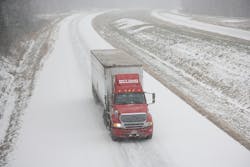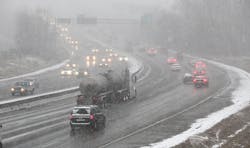Everyone knows operating tractor-trailers during the winter comes with some big risks. But did you know that, on average 467 fatalities are associated with icy driving conditions annually, or that 23% of all vehicle crashes every year – some 1.3 million – are caused in part by inclement weather, such as rain, sleet, snow, fog, and wind? (Those weather-related findings are courtesy Federal Highway Administration research, by the way).
On top of that, cold weather can cause diesel fuel to thicken into “gel” or get waterlogged, potentially damaging a truck’s fuel system and engine. Colder temperatures also affect fuel economy, too, by increasing tire rolling resistance and reducing aerodynamic efficiency, to name just two impacts.
“As winter approaches, we want to equip fleets and their drivers with the best information available for increasing safety on America’s congested and frequently traveled roads,” noted Dean Croke, VP of analytics at Omnitracs, LLC. “With fewer daylight hours and compromised road conditions, seasonal weather creates many challenges for truck drivers.”
Croke breaks down his winter operation advice down into two groups, one focused on drivers and one on equipment. For drivers:
- Slow down and be cautious in adverse weather such as rain, sleet, snow, fog and wind.
- Always buckle up; safety belts reduce the risk of fatal injury by 45%, according to the National Highway Traffic Safety Administration (NHTSA).
- Keep extra water and non-perishable food in the cab; dehydration and malnourishment can cause weakness, dizziness, confusion, sluggishness, fainting and more, according to WebMD.
- Use sun sleeves, window covers, sunglasses and protective clothing in daylight to avoid the deceptive winter glare.
- Be wary of seasonal affective disorder, a common ailment in which reduced sunlight negatively affects mood and other mental health issues.
In terms of vehicle maintenance, Croke offers these tips:
- Maintain tire traction and overall tire “health,” for in one of every 11 crashes, according to NHTSA, there was an issue with a tire before the crash occurred.
- Look for uneven patterns on tires, these are a great indicator of uneven wear caused by poor alignment, worn bearings and/or kingpin wear.
- Look for steam or melted snow coming off wheel hubs, as this could be a signal for over-heating wheel bearings.
- Check battery charge and windshield wipers, keep windows clean for maximum visibility, monitor anti-freeze levels and put no-freeze fluid in the washer reserve.
- Use white snow to check for fluid leaks after you have been parked for a while.
Michael Spence, senior VP of fleet services at Fleet Advantage, recently penned a white paper delving into how winter weather can impact commercial truck operations. For example:
- Cooler ambient temperatures decrease engine efficiency and increase aerodynamic drag, with every 10 degree drop in Fahrenheit equating to a 2% increase in aerodynamic drag.
- Tires lose pressure as temperatures drop and rolling resistance increases, thus reducing fuel economy.
- Rain, snow and slush all increase tire rolling resistance as well, with cold water significantly cooling tires plus transmission and rear axle lubricants. This results in a 0.2 to 0.3 MPG [miles per gallon] loss as cited by the Society of Automotive Engineers (SAE) data.
- Headwinds/crosswinds impact MPG as well, with every 10 mph worth of wind equating to a 13% drop in MPG.
- Engine idle time increases in the winter months as drivers seek to stay warm, while poor driving conditions brought on by the cold and snow lead to decreased use of cruise control.
Yet its winter’s impact on the composition of diesel fuel that can cause the most trouble, Spence told American Trucker.
“It really starts with the need to get the truck started and getting fuel to the engine; and water is the biggest problem there,” he explained. “Water settles to the lowest point in a hose, tank or fuel filter and then freezes. So it’s important to keep water out of all fuel sources.”
What’s more, “fuel gelling” is a big problem, too, Spence emphasized.
“The molecules of the fuel ‘gel up’ or ‘wax up’ since they slow down and cling together in cold weather,” he noted. “When the waxed fuel gets to a filter, it can't pass through. Kerosene has been known to be used to break up those ‘waxed’ diesel molecules, but Kerosene is very expensive, which is why other additives have also been introduced.”The problem for fleets is that this is more than just truck maintenance issue, Spence stressed.
“This can also cost fleets a lot of money since it can also cause trucks to experience lower MPG,” he said. “This means you’re spending more on fuel, in addition to any additional maintenance and repair costs needed to service trucks that have frozen over.”
Keep one more thing in mind, Spence cautioned, since this “gelling” issue can become an issue for trucks stationed in warm weather climates during the winter months.
“Many transportation routes run north and south,” he explained. “This means that trucks originating in the south also need to winterize their fuel since they may be traveling up north. Many times, those drivers aren’t thinking of how the weather can affect them since they’re starting out in a warmer climate.”
To Spence’s mind, those types of conversations ultimately come back to the kinds of data fleets record and analyze.
“Whether it’s having data to identify your fuel costs and fuel efficiency, or data on what type of weather you will be experiencing on your route, it’s important for fleets today to have access to the right business intelligence,” he stressed. “That way, they can make the right decisions to keep their drivers safe and productive, while also maximizing cost efficiencies for the entire fleet.”
About the Author
Sean Kilcarr
Editor in Chief
Sean Kilcarr is a former longtime FleetOwner senior editor who wrote for the publication from 2000 to 2018. He served as editor-in-chief from 2017 to 2018.

